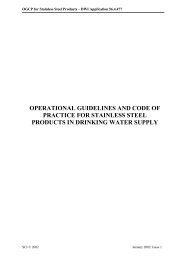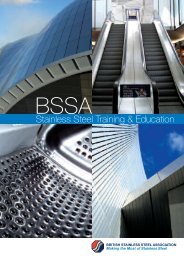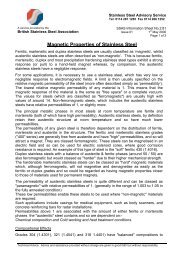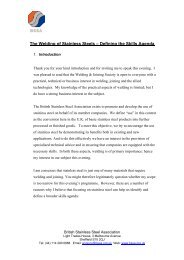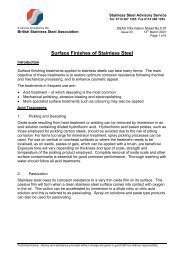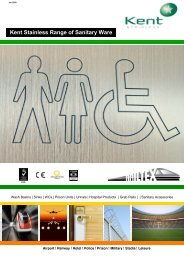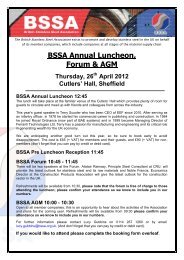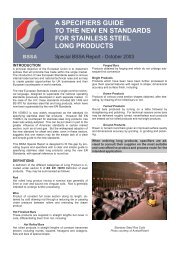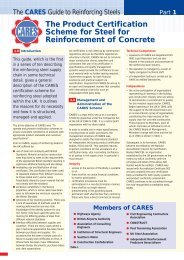Chris Quinn Conference 2000 paper.pdf - British Stainless Steel ...
Chris Quinn Conference 2000 paper.pdf - British Stainless Steel ...
Chris Quinn Conference 2000 paper.pdf - British Stainless Steel ...
Create successful ePaper yourself
Turn your PDF publications into a flip-book with our unique Google optimized e-Paper software.
BSSA <strong>Conference</strong> <strong>2000</strong><br />
The Water Industry’s Balancing Act: Maximising Process Availability at<br />
Minimum Cost<br />
Demands on the Water Industry come from several directions:<br />
The Water Industry’s regulator ( OFWAT ) - demands a Capital<br />
Investment programme that not only ensures infrastructure replacement<br />
keeps place with wear and tear but also makes up for the deficiencies<br />
resulting from the times when this investment was part of the Public Sector<br />
Borrowing Requirement.<br />
Legislation - EU and UK Government Legislation require capital<br />
investment to meet ever tighter standards. The Drinking Water Inspectorate<br />
oversees the programme for improved drinking water quality with the<br />
Environment Agency responsible for river quality and other environmental<br />
improvements generally brought about by reduced abstraction from rivers and<br />
groundwater.<br />
OFWAT and Customers - wish to see operating efficiency<br />
improvements result in reduced consumer bills.<br />
Shareholders - want a continually improving return on their investment.<br />
These pressures can be resolved by individual Water Companies as:<br />
Minimising the capital investment required to achieve an outcome –<br />
traditionally the water industry adopted a conservative approach to design so<br />
that plant could be operated at less than full rated load. Extra plant items<br />
would be installed to cover operating units in case of breakdown or<br />
maintenance requirements. Nowadays much effort is put into risk<br />
assessment so that design and operating standards are more akin to other<br />
process industries.<br />
Reducing operating costs – the widespread use of advanced control<br />
and monitoring techniques have been used to minimise the requirement for<br />
plant operators and maintenance staff. Unfortunately, the majority of modern<br />
treatment processes require a greater energy input than the more traditional<br />
ones.<br />
Maximising the reliability of installed plant – at the design and<br />
procurement stages the use of “duty” specifications is now almost universal.<br />
Where plant is required to operate continuously, the specification is likely to<br />
include the requirement for, say, “96% availability”. This tends to focus<br />
design teams on the simplification or removal of maintenance operations. In<br />
this way the risk of environmental damage from equipment failure or<br />
<strong>British</strong> <strong>Stainless</strong> <strong>Steel</strong> Association<br />
Light Trades House, 3 Melbourne Avenue<br />
Sheffield S10 2QJ<br />
Tel: (44) 114 290 0888 Email: enquiry@bssa.org.uk Web: www.bssa.org.uk
downtime for maintenance is minimised. No Water Company wishes to incur<br />
fines or, worse still, the adverse publicity surrounding a failure to comply with<br />
a regulatory standard.<br />
The “Balance” between Capital and Operating costs is well understood and can be<br />
calculated with relative ease. The inclusion in that calculation of a companies<br />
reputation, affecting, as it does, it’s perceived worth to investors and the publics<br />
confidence in it’s ability to provide them with life sustaining services is beyond normal<br />
calculation. It is however the “Balancing act” that water Companies have to perform<br />
on a daily basis.<br />
This <strong>paper</strong> seeks to encourage both water companies and their suppliers to re-look<br />
at plant design as a way of reducing the costs and risks of ownership of equipment<br />
essential to the industry. It does it by way of an example which demonstrates the<br />
magnitude of benefits available to, I believe, anyone who makes the effort to take this<br />
approach.<br />
The Huddersfield Waste Water Treatment Works ( WWTW ) is one of the most<br />
heavily loaded in the UK. The actual population served by the works is 170,000<br />
whereas the “equivalent” population, taking into account the industrial load, is<br />
790,000. The topography of the Colne valley imposed severe limitations on the<br />
amount of land available for a WWTW and resulted in the process being split<br />
between three sites over a distance of 3km.<br />
The works inlet, screening and primary settlement are at Deighton. At Heaton<br />
Lodge, the first stage of biological treatment takes place on some 25,000m 2 of<br />
percolating filters. Secondary filtration, also on percolating filters, and final discharge<br />
takes place on the Cooper Bridge site.<br />
Like many other works of this type, it was built in stages as more capacity was<br />
required. Refurbishment has also been an ongoing activity.<br />
In 1996 the decision was made to refurbish the Heaton Lodge site. This work was to<br />
involve replacement and upgrading of the filter effluent pumps and a major overhaul<br />
of the 30 year old gantry type filter distributors. YW Research & Process<br />
Development, where I worked at the time, became involved as part of the project<br />
team that would determine the extent of the work required. Initial thoughts were that<br />
complete dismantling of the distributors followed by grit blasting, repainting and<br />
replacement of all mechanical parts and the rail system would extend the life of the<br />
installation by 20 years.<br />
As part of the justification procedure for the work a comparison between the Heaton<br />
Lodge maintenance costs and those at Cooper Bridge, a works of the same capacity<br />
equipped with a later version of the same machines that were refurbished some 3<br />
years ago, was made. This comparison revealed that all was not well and that not<br />
only were maintenance costs escalating towards those experienced before<br />
refurbishment, but that failures similar to those being experienced at Heaton Lodge<br />
were the basis of those costs.<br />
<strong>British</strong> <strong>Stainless</strong> <strong>Steel</strong> Association<br />
Light Trades House, 3 Melbourne Avenue<br />
Sheffield S10 2QJ<br />
Tel: (44) 114 290 0888 Email: enquiry@bssa.org.uk Web: www.bssa.org.uk
At this stage a more thorough analysis of maintenance records was combined with a<br />
critique of the design to try to determine the root causes of the problem. In broad<br />
terms the report determined that<br />
some of the problems were caused by wear and tear but the majority were the<br />
result of design deficiencies. In a recent 12 month period maintenance costs of<br />
£80,000 had been incurred. This was associated with a 78% plant ( process )<br />
availability and a 12% works compliance failure.<br />
Filter outages were, in the main, caused by the following:<br />
+ Wheel, Wheel bearing and rail track failures – the difficulty in achieving<br />
and maintaining accurate wheel alignment over such large track gauges<br />
resulted in wheel flange wear and excess wheel bearing loads.<br />
+ Haulage rope breakages – several kilometres of wire rope were used in the<br />
haulage systems. Because the distributors had to be attached to the haulage<br />
ropes at both ends, the rope and pulley arrangement was complex. Despite<br />
rope failure sensors, it was possible for a rope breakage to result in machine<br />
derailment and serious damage to the cast iron and steel components of the<br />
distributors. The Company maintenance engineers were divided on the best<br />
way of minimising the “collateral” damage resulting from rope failure – one<br />
school of thought kept the ropes under high tension which helped machine and<br />
wheel alignment but resulted in pulley bearing failures. The other school kept<br />
the ropes slacker which minimised pulley bearing failure but increased wheel<br />
problems.<br />
+ Drive failures, principally gearboxes, but some electrical control<br />
problems – included in the drive train was a worm reduction gearbox. This had<br />
to reverse each time the distributors reached the end of their travel. The<br />
lubrication problems associated with reversing a worm gear are well<br />
documented and caused some failures in as little as 18 months. Even with star<br />
delta starting the inefficiency of the drive imposed a high load on motor control<br />
gear as acceleration takes place under full load conditions. Combined with the<br />
age of the starters, this caused it’s share of machine stoppages.<br />
+ Blockage of the holes in the distribution sparge pipes – the perennial<br />
problem with most distributors. Caused principally by debris that avoids the<br />
works inlet screens.<br />
It was also evident that the riveted steel supporting frames were corroded to the point<br />
where replacement of some frame members ( generally at bottom of the structure ) was<br />
required. The frames, which were almost 15m long, had to support their own weight<br />
plus that of the distribution pipe assemblies - a total of approximately 1.8 tonnes. Had<br />
the frames been of a welded construction, repair followed by shot blasting and the<br />
application of an epoxy paint system would have extended their life. Unfortunately the<br />
riveted construction employed had allowed corrosion to develop within the joints where<br />
shot blasting would have no effect.<br />
<strong>British</strong> <strong>Stainless</strong> <strong>Steel</strong> Association<br />
Light Trades House, 3 Melbourne Avenue<br />
Sheffield S10 2QJ<br />
Tel: (44) 114 290 0888 Email: enquiry@bssa.org.uk Web: www.bssa.org.uk
The bottom line was that no amount of refurbishment would increase the reliability of the<br />
plant sufficiently to meet it’s operational obligations. Either the process would have to<br />
be changed, almost certainly involving the demolition of the filters or a different<br />
approach to distribution of the effluent over the filters was needed.<br />
An outline specification and design using Structural Hollow Section ( SHS ) as the<br />
basic construction medium was evolved. Each pair of the existing gantry machines<br />
would be replaced by a single cantilever type running on rails at the base of the<br />
channel walls. The design addressed all the deficiencies of the existing machines<br />
and was estimated to be capable of saving at least 50% of maintenance costs over<br />
it’s predicted life and increase process availability to in excess of 97%.<br />
At that time Yorkshire Water was involved in what was proving to be a very<br />
successful R&D project with Adams Hydraulics of York. They were asked to<br />
appraise the proposed design and provide budget costs for carrying out the works.<br />
Discussions with Adams proved extremely fruitful. A plan emerged for a two stage<br />
project where, because of tight timescales involving the Environment Agency’s<br />
requirement for an improved effluent quality, the design of replacement distributors<br />
was to evolve over the four sets of equipment required.<br />
Sets 1 to 3 would be constructed with conventional tubular steel distribution arms and<br />
set 4 with a set of high-tech channel arms. This modification, which would be an<br />
extension of some existing research work, would be suitable for retro-fitting to sets 1<br />
to 3 at some point in the future. In view of the environment in which the plant was to<br />
work ( chloride, measured at the inlet works, in the region of 300mg/l ) , the design<br />
life of 20 years, the difficulty of not damaging protective coatings during maintenance<br />
and the impossibility of maintaining a 97% plant availability if replacement of the<br />
protective coating became necessary, Adams proposed that the main chassis be<br />
fabricated from S31600 stainless steel SHS.<br />
As soon as contractual matters were agreed ( which took rather longer than it should<br />
and impinged heavily on Adams design and manufacturing time ) some of the less<br />
obvious advantages of <strong>Stainless</strong> fabrication became evident:<br />
+ The main chassis needed to be very stiff laterally to maintain wheel<br />
alignment but less so longitudinally so that flexure could accommodate<br />
uneven wheel loadings resulting from the inevitable inaccuracies that arise<br />
from the fabrication and rail laying processes. The availability of a wide size<br />
range of SHS simplified this design.<br />
+ The “A” frame that supports the arms was to be in galvanised mild steel but<br />
as the design evolved it became clear that it would be more economic to<br />
manufacture it in S30400 stainless.<br />
+ The time consuming process of preparation and surface coating was<br />
avoided.<br />
+ The use of <strong>Stainless</strong> <strong>Steel</strong> required no corrosion allowance. This combined<br />
with rigorous structural design methods allowed a much lighter design than<br />
would have otherwise been achieved. In turn this reduced transport and<br />
<strong>British</strong> <strong>Stainless</strong> <strong>Steel</strong> Association<br />
Light Trades House, 3 Melbourne Avenue<br />
Sheffield S10 2QJ<br />
Tel: (44) 114 290 0888 Email: enquiry@bssa.org.uk Web: www.bssa.org.uk
craneage costs and got around many of the problems of a very restricted site<br />
access.<br />
+ Site assembly time was minimised because there was no need for any<br />
precautions to avoid surface damage and no repair of damaged surfaces<br />
before wet commissioning. As the plant was running with only 75% process<br />
availability while each set was being “swapped” anything that reduced the<br />
time “at risk” was welcomed by Yorkshire’s operational staff.<br />
The other design issues were tackled in an equally competent manner by Adams<br />
staff. A new haulage configuration utilising a multistage spur reduction gearbox, a<br />
soft start and stop combined with electronic variable speed and the location of all<br />
control and safety sensors either on the drive unit or immediately outside the drive<br />
house, overcame the problems of the existing drive arrangement. The new<br />
distributors ran on rails adjacent to the bottom of the effluent feed channel walls.<br />
Although this means that only half of the rails previously used were needed, it did<br />
mean that rail alignment, both gauge and height were more critical. Once an<br />
accurate technique was developed for rail alignment a tolerance of 2mm on gauge<br />
and 1mm on height were achieved. To minimise corrosion problems in this very<br />
vulnerable area, the rail mounting chairs had elastomer inserts so as to avoid crevice<br />
corrosion. The chairs were fixed with S31600 resin anchors. During the running in<br />
period it was evident that the wheels were not as accurately aligned as was required<br />
despite the careful use of an assembly fixture by the fabricator. Again Adams<br />
designers produced a simple but elegant fix for the problem that was fitted on site<br />
with minimal disruption.<br />
Adams sub-contracted the <strong>Stainless</strong> <strong>Steel</strong> fabrication to Minster Engineering Ltd. of<br />
York. Their efforts in accurate cutting and fitting of Rectangular Hollow Section and<br />
good welding procedures combined with the use of pickling paste for the effective<br />
removal of weld tint produced a fabrication that emphasises the elegance and<br />
efficiency of the Adams structural design.<br />
Two years on with all the teething problems that are inherent in a new design behind<br />
us, how is the system performing?<br />
The latest figures from Yorkshire Water suggest that, so far at least, maintenance<br />
has been cut not by the 50% expected but by in excess of 90%. Some minor<br />
components failures have occurred but generally operational staff are very happy<br />
with the outcome. The 97% process availability target is a little more difficult to<br />
measure accurately but best estimates are nearer 98% availability.<br />
What of Adams then?<br />
Before the Huddersfield contract was complete Yorkshire Water were sufficiently<br />
confident of the outcome that they awarded them a further major contract for the<br />
supply of similar machines at the nearby Dewsbury works. Since then a further set of<br />
machines has been installed at Mexborough. Amongst the other Water Companies,<br />
one major installation has taken place with several others in the pipeline.<br />
And what about the “Water Industry’s Balancing Act”?<br />
<strong>British</strong> <strong>Stainless</strong> <strong>Steel</strong> Association<br />
Light Trades House, 3 Melbourne Avenue<br />
Sheffield S10 2QJ<br />
Tel: (44) 114 290 0888 Email: enquiry@bssa.org.uk Web: www.bssa.org.uk
This is essentially about realistic whole life costing. It is probably true to say that all<br />
process problems are soluble if sufficient money is spent on the right capital solution.<br />
The real difficulty arises when the true operating costs of the plant are revealed. In<br />
this case the extra capital expenditure required to replace the plant rather than<br />
refurbishing it is more than off-set if the assumptions that we made about<br />
maintenance costs and process availability ( i.e. plant reliability ) prove correct, and<br />
I’m coming around to the view that they were somewhat pessimistic, then the<br />
balance tips firmly in the Water Companies favour! Without counting the benefits of<br />
increased process availability a payback period of under three years looks likely.<br />
© <strong>Chris</strong> <strong>Quinn</strong>, November <strong>2000</strong><br />
This <strong>paper</strong> was originally presented at the BSSA <strong>Conference</strong> ‘Make it in<br />
<strong>Stainless</strong>’ on 9 th November <strong>2000</strong> at the National Motorcycle Museum,<br />
Birmingham<br />
<strong>British</strong> <strong>Stainless</strong> <strong>Steel</strong> Association<br />
Light Trades House, 3 Melbourne Avenue<br />
Sheffield S10 2QJ<br />
Tel: (44) 114 290 0888 Email: enquiry@bssa.org.uk Web: www.bssa.org.uk



